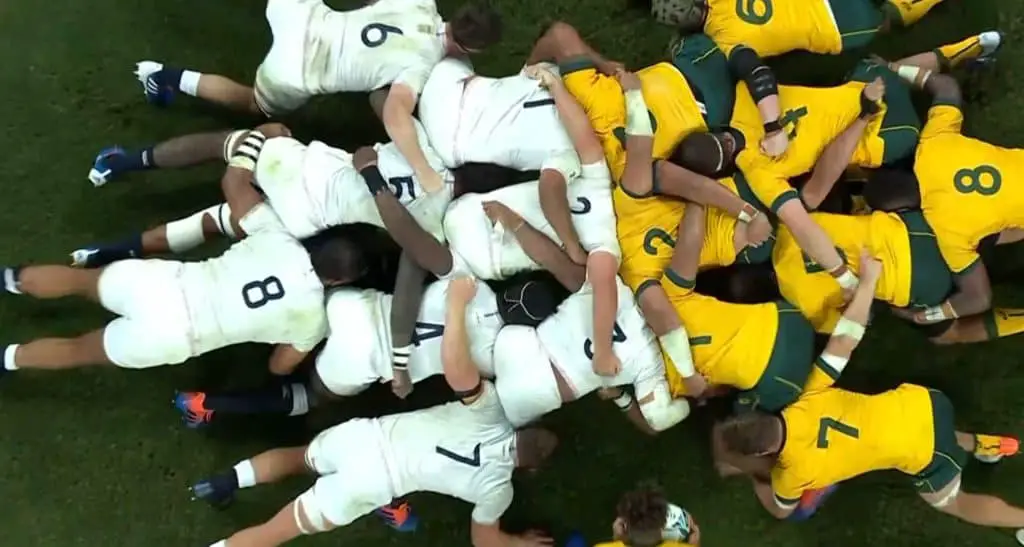
Rugby is a game with many unique characteristics. One of those quirks is a phase of play known as a scrum. A scrum is where the two opposite sides forward packs crouch down and bind against each other creating one huge blob and push against each other in hopes of driving over the ball and securing possession for their side.
Scrums have always been considered the dark arts in rugby. There is a lot of mystery to the scrum and techniques have long been guarded by teams.
Why do scrums happen in rugby?
Scrums occur in rugby after minor infractions. The most common cause of scrums are knock ons where a player loses the ball forward. Forward passes are also a major cause of scrums. After being awarded a penalty teams also have the option of having a scrum.
Scrums occur in rugby for a variety of reasons. The most common reason for a scrum in rugby is due to a knock on. Forward passes also result in scrums.
When a team is awarded a penalty they also have the option of taking a scrum but this is rare as most sides opt to kick for touch or if they are close enough to the goal posts kick for goal. Occasionally a team will choose a scrum when they are very close to the try line and they need a try to win and they have more faith in their ability to score from a scrum compared to a lineout.
Scrums are very common in rugby with typically more than 10 occurring each game. It is not uncommon to see matches with 20 + scrums taken. As scrums take a long time to set up and complete there have been games where over 20 minutes of an 80 minute match have been dedicated just to the scrum.
Are Rugby Scrums Dangerous?
Rugby scrums are dangerous. Scrums are the major cause of spinal injuries in rugby, responsible for 35% of paralysis cases. Scrums result in 3.43 spinal injuries 100,000 player‐years. Scrums are particularly dangerous for hookers and props who suffer over 90% of scrum related injuries.

The amount of weight and force involved in a scrum places players, particularly the front row at significant risk of injury. With forward packs now weighing over 900kg if this weight is distributed incorrectly players can suffer some horrific injuries.
During scrum a large amount of force is distributed through the front row’s backs and neck. If they suffer from back and neck rounding due to being overwhelmed by the force or the scrum collapses on them while their body is in a dangerous position the risk of serious spinal cord injuries is high.
Scrums are responsible for 35% of spinal injuries in rugby, which is by far the leading cause. Scrums are to blame for 3.43 spinal injuries 100,000 player‐years.
If you are a front row forward, scrums are dangerous as they place you at considerable risk of suffering serious neck, back and spinal injuries which can be catastrophic and permanent.
What Do Rugby Players Say In A Scrum?
In a scrum rugby players will shout “hit” as they two sides make contact and “2,3,4” as the players drive and attempt to push the opposition side backwards. The purpose of the players yelling these commands is to motivate each other and ensure the players are moving in unison.

If you have watched a rugby match you may have noticed a lot of screaming during scrum time. The yelling is just some show of machismo, it serves a specific purpose.
Rugby players scream the word “hit” as the players make contact with their opposition and then yell “2,3,4” as you use their legs to drive the opposing backwards. The call not only inspires the players to fight hard to win the scrum but it also helps players stay in rhythm, ensuring all players are moving as one cohesive movement, allowing them to generate greater amounts of force compared to if they were pushing out of sync.
Does The Ball Have To Go In Straight In A Scrum?
The ball does have to go straight in a scrum. However, half backs are well versed in spinning the ball to ensure it may enter the scrum straight but quickly curls towards their side’s scrum. Referees have tolerated more and more slanted put ins.

The ball must be fed straight into a scrum. Over the years scrum halves have continued to push the envelope to see what they can get away with. Nowadays halfbacks put heavy spin on the ball when putting in a scrum so even though the ball may enter straight it immediately starts bending towards their own side, making it far easier to win a scrum and giving the opposition little chance of competing.
Referees once were very strict about the ball being fed dead straight. However, over the years referees have become more lenient and allowed halfbacks to put a heavy slant on their feeds.
This may be because scrums are often very time consuming, many fans find them boring and they are hard to referee as penalties can often go either way putting referees in the firing line for harsh criticism.
How Do You Win A Scrum?
You win a scrum by hooking the ball to your side and driving over the ball onto it comes out the back of the scrum on your side. You can also win a scrum by winning a penalty through forcing the opposition to collapse or wheel the scrum.

The most common way to win a scrum is the half back feeds the ball puts a spin on the ball so it heads to his team’s side. The hooker strikes the ball backwards with his boot and the scrum drives over the ball until the half back picks it up from the back of the scrum.
The second most common way to win a scrum is to be awarded a penalty. Scrums are a penalty fest with over 20% of them ending up in one side being penalised. The most common reason for penalties at scrum time are collapsing the scrum, early hit, incorrect binding and wheeling the scrum.
While it is rare it does occasionally happen where a rugby team who is not putting the ball in will win a scrum without being awarded a penalty. Sometimes you will see a lever hooker outstrike his opposition and hook the ball back towards his own side. Or you may see the defending side put on a huge push and drive over the ball.
Conclusion
Scrums in rugby are a strange phase of play, many people claim to understand them but they continue to be shrouded in mystery. Scrums occur after minor infractions on the field with knock ons being the major cause.
To win a scrum you need to hook it back towards your side and drive over the ball until it emerges at the back of the scrum. The other way to win a scrum is to put so much pressure on the opposition scrum that they give up a penalty through collapsing or wheeling the scrum.
Even though scrums can be a great spectacle, unfortunately they are dangerous. Scrums are the leading cause of spinal injuries in rugby and are responsible for 35% of paralysis cases.
